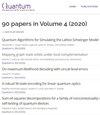量子乐高和XP稳定器代码
IF 5.1
2区 物理与天体物理
Q1 PHYSICS, MULTIDISCIPLINARY
引用次数: 0
摘要
我们将最近的“量子乐高”图形框架应用于XP稳定器代码,其中稳定器群通常是非阿贝尔的。我们证明了算子匹配的思想仍然适用于这样的代码,并且足以生成它们所有的XP对称性,只要结果代码是XP。我们提供了一种有效的经典算法来跟踪这些张量收缩或连接下的对称性。这构成了Gottesman-Knill定理所隐含的算法在Pauli稳定状态和Clifford运算之外的部分推广。因为连接变换产生的量子操作是通用的,所以从这些算法获得的XP对称性通常不能唯一地标识结果张量。利用这个扩展框架,我们提供了比现有非平凡XP正则码具有更高距离的新型XP稳定器代码和具有容错T门的$[[8,1,2]]$泡利稳定器代码的示例。对于XP正则码,我们还使用权值枚举器构造了一个基于张量网络的最大似然解码器,用于任意独立和同分布的单量子位错误通道。本文章由计算机程序翻译,如有差异,请以英文原文为准。
Quantum Lego and XP Stabilizer Codes
We apply the recent graphical framework of "Quantum Lego" to XP stabilizer codes where the stabilizer group is generally non-Abelian. We show that the idea of operator matching continues to hold for such codes and is sufficient for generating all their XP symmetries provided the resulting code is XP. We provide an efficient classical algorithm for tracking these symmetries under tensor contraction or conjoining. This constitutes a partial extension of the algorithm implied by the Gottesman-Knill theorem beyond Pauli stabilizer states and Clifford operations. Because conjoining transformations generate quantum operations that are universal, the XP symmetries obtained from these algorithms do not uniquely identify the resulting tensors in general. Using this extended framework, we provide examples of novel XP stabilizer codes with a higher distance than existing non-trivial XP regular codes and a $[[8,1,2]]$ Pauli stabilizer code with a fault-tolerant $T$ gate. For XP regular codes, we also construct a tensor-network-based maximum likelihood decoder for any independently and identically distributed single qubit error channel using weight enumerators.
求助全文
通过发布文献求助,成功后即可免费获取论文全文。
去求助
来源期刊

Quantum
Physics and Astronomy-Physics and Astronomy (miscellaneous)
CiteScore
9.20
自引率
10.90%
发文量
241
审稿时长
16 weeks
期刊介绍:
Quantum is an open-access peer-reviewed journal for quantum science and related fields. Quantum is non-profit and community-run: an effort by researchers and for researchers to make science more open and publishing more transparent and efficient.
 求助内容:
求助内容: 应助结果提醒方式:
应助结果提醒方式:


